Archaeological Area and the Patriarchal Basilica of Aquileia: Aquileia is an ancient Roman city in Italy. Aquileia is located east of Venice close to the border of Slovenia. Aquileia was one of the largest and wealthiest cities of the Early Roman Empire. Aquileia was founded by the Romans in 181 BC. The Basilica of Aquileia (Patriarchal Basilica of Aquileia) was built in 1031 on the site of an earlier 4th century church. The Basilica of Aquileia is renowned for its mosaics from this 4th century church. The floor mosaics covers about 750 square meters. The Patriarchal Basilica played an important role in the spread of Christianity into a large part of Central Europe during the early Middle Ages. Among the remains of the Early Roman Empire are the Roman Forum and Roman Harbour along the Via Sacra (Sacred Way). Most of the Roman city of Aquileia still lies unexcavated beneath the fields and roads. The Archaeological Area of Aquileia is probably the largest Roman city yet to be excavated, but the most famous archaeological areas in Italy are Pompeii and Herculaneum. The Archaeological Area and the Patriarchal Basilica of Aquileia gained status as a UNESCO World Heritage in 1998.
www.werelderfgoedfotos.nl © Copyright World Heritage Photos
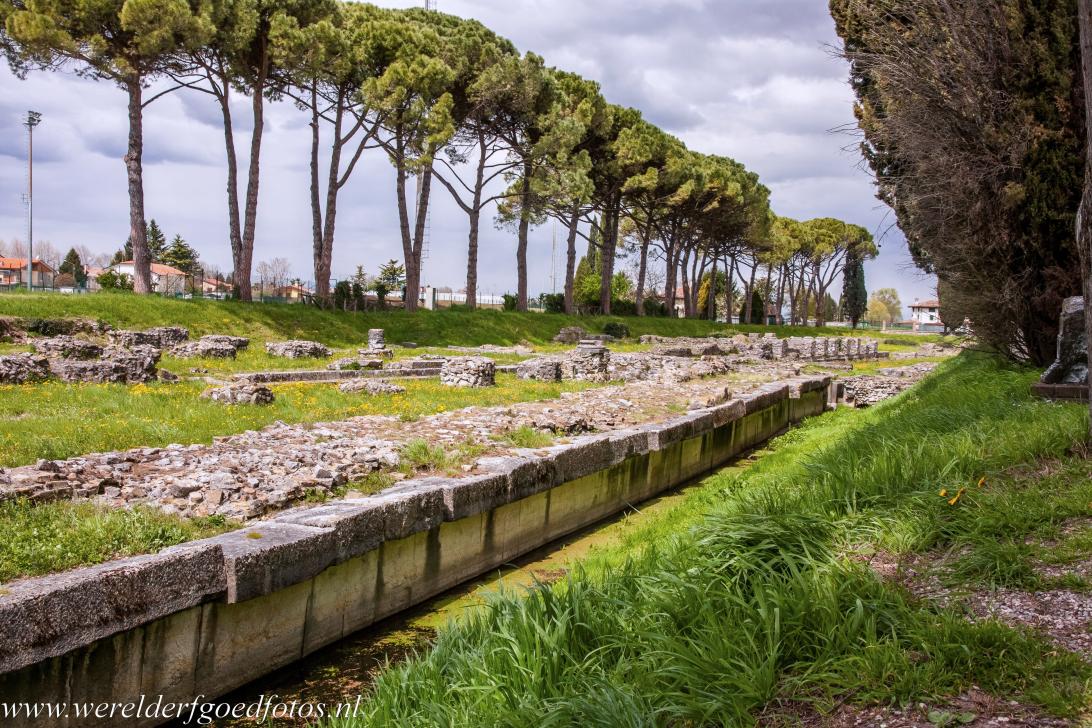
Archaeological Area and the Patriarchal Basilica of Aquileia: The remains of the Roman harbour along the Via Sacra, the Sacred Way. Aquileia was one of the largest and wealthiest cities of the Early Roman Empire. The Archaeological Area and the Patriarchal Basilica of Aquileia gained the status as a UNESCO World Heritage in 1998.

Archaeological Area and the Patriarchal Basilica of Aquileia: The remains of the Roman harbour along the Via Sacra, the Sacred Way. Aquileia was one of the largest and wealthiest cities of the Early Roman Empire. The Archaeological Area and the Patriarchal Basilica of Aquileia gained the status as a UNESCO World Heritage in 1998.

Archaeological Area and the Patriarchal Basilica of Aquileia: The Basilica of Aquileia was built in 1031 on the site of an earlier church from the 4th century. The basilica was consecrated by the 57th patriarch of Aquileia, Poppo of Treffen. The basilica is dedicated to the Virgin Mary. The city of Aquileia was founded by the Romans in 181 BC. In the second century AD, Aquileia was one of the largest cities in the world, it had more than 1000,000 inhabitants.
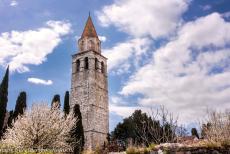
Archaeological Area and the Patriarchal Basilica of Aquileia: The tower of the Patriarchal Basilica of Aquileia is a freestanding bell tower, called Poppo's Bell Tower, named after Poppo of Treffen, the 57th patriarch of Aquileia from 1019 to 1045, he ordered to build the basilica and tower. The bell tower was built in 1031. The octagonal lantern was added in the 16th century, the bell tower is now 73 metres high. From April to September, it is possible to climb the tower.
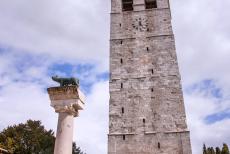
Archaeological Area and the Patriarchal Basilica of Aquileia: Right in front of Poppo's Bell Tower stands a small statue of the mythical she-wolf suckling the twins Romulus and Remus. According to legend, Romulus was the founder and first king of Rome. Since ancient times, the she-wolf is a symbol of Rome and the Roman Empire. The bronze statue is a replica of the Capitoline Wolf and was given to Aquileia by the city of Rome in 1919.
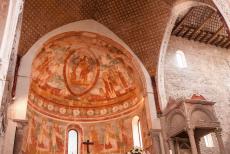
Archaeological Area and the Patriarchal Basilica of Aquileia: The apse of the Basilica of Aquileia is embellished with frescoes from the 11th century. The basilica is an important monument of Christianity, the Basilica of Aquileia played an important role in the spread of Christianity into a large part of Central Europe during the early Middle Ages. The Basilica of Aquileia is famous for its mosaics from an earlier 4th century church.
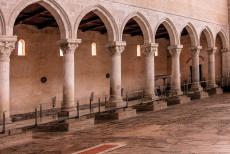
The Archaeological Area and the Patriarchal Basilica of Aquileia: The basilica is renowned for its frescoes and mosaics from an earlier Christian church dating from the 4th century. The mosaics can be viewed from the surrounding glass walkway. The floor mosaics cover some 750 square metres. The amazing mosaics from the 4th century church were not revealed until the floor of the 11th century basilica was removed in 1909.
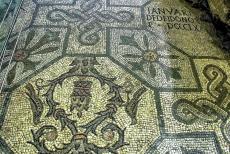
Archaeological Area and the Patriarchal Basilica of Aquileia: A floor mosaic from the 4th century church. The city of Aquileia was for thirteen centuries the seat of the Ecumenical Patriarchate, which lasted until 1751. Aquileia was proclaimed by the Vatican as one of the five Jubilee cities in Italy. Aquileia preserves both early Christian and Roman monuments.
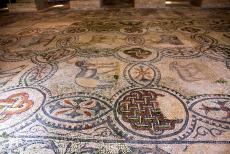
Archaeological Area and the Patriarchal Basilica of Aquileia: One of the ancient floor mosaics from the 4th century church. The Basilica of Aquileia preserves the largest and most spectacular early Christian mosaics in the Western world, the mosaics depict scenes such as stories from the Bible and the four seasons. The Archaeological Area and the Patriarchal Basilica of Aquileia were declared a UNESCO World Heritage in 1998.

Archaeological Area and the Patriarchal Basilica of Aquileia: A floor mosaic in the Crypt of the Slaves. During the 4th century, Imperial residences and a church were built in Aquileia. Aquileia was destroyed by Attila and his Huns in 452. In the 9th century, a new basilica was built on the site of the earlier 4th century church. Despite the invasion of the Magyars and an earthquake in 988, the Patriarchal basilica was completed in 1031.
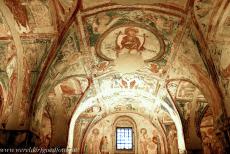
Archaeological Area and the Patriarchal Basilica of Aquileia: The Crypt of the Frescoes was built in the 9th century and was later decorated with Byzantine-style frescoes in the 12th century by orders of Bishop Ermanno. The frescoes depict various scenes from the life of Christ. The crypt is situated under the main altar of the Patriarchal Basilica of Aquileia.
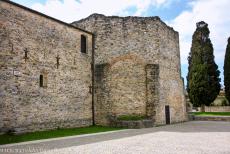
Archaeological Area and the Patriarchal Basilica of Aquileia: The remains of the baptistery. The baptistery was built in the 5th century and is situated next to the Patriarchal Basilica of Aquileia. The baptistery has the shape of an octagon in order to recall the octava dies, the eighth day: the Day of Resurrection. The Basilica of Aquileia was built in the Romanesque style and has some Gothic elements.
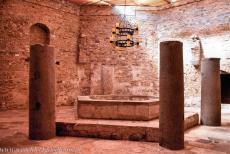
The Archaeological Area and the Patriarchal Basilica of Aquileia: The remains of the 5th century baptistery. The huge baptismal font is situated in the middle of the baptistery and is surrounded by four columns, they were built later, probably in the 9th century. The baptismal font was used for full immersion baptisms. Steps lead into the hexagonal baptismal font. The baptisterium was connected to the Basilica of Aquileia by a portico.

Archaeological Area and Patriarchal the Basilica of Aquileia: The Roman Forum in Aquileia. The Roman Forum was the heart of the public life, it was erected in the 2nd- 3rd century AD. Aquileia was one of the largest and wealthiest cities of the Early Roman Empire. Most of the Roman city of Aquileia still lies unexcavated beneath the fields and roads of the city. The archaeological area of Aquileia is probably the largest Roman city yet to be excavated.
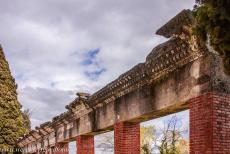
The Archaeological Area of Aquileia: The remains of the Roman Harbour are situated along the Via Sacra. The main gate into the inland harbour was built in the 2nd century BC. Aquileia was founded in 181 BC as an Roman military outpost against the Barbarians. In the 5th century, the city was sacked and destroyed by Attila and his Huns, but it would rise again. The Archaeological Museum of Aquileia exhibits artefacts from the Roman period found in Aquileia.
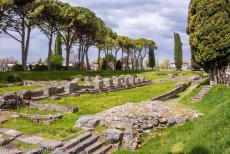
Archaeological Area and the Patriarchal Basilica of Aquileia: The ancient inland harbour and the ruins of the storage rooms, The harbour is located along the Via Sacra, (Sacred Way), the main street in Roman Aquileia. The Via Sacra is located behind the Patriarchal Basilica of Aquileia. The Archaeological Area and Patriarchal Basilica of Aquileia were inscribed on the UNESCO World Heritage List in 1998.
